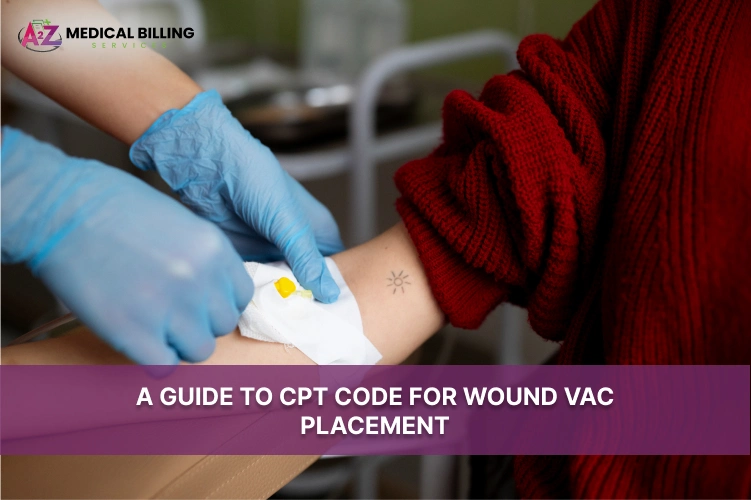Identifying and applying the correct CPT code for wound VAC placement is crucial for a medical practice to secure appropriate reimbursement. Accurate coding ensures that healthcare providers have utilized the proper code, rendered the precise services, and adhered to billing regulations established by insurance companies and healthcare regulators.
Proper use of the CPT code not only facilitates timely payments but also minimizes claim denials and audits. By ensuring precise documentation and coding, healthcare providers demonstrate compliance with industry standards, optimize revenue cycle management, and uphold the integrity of the billing process.
Type of Wound VAC Placement
There are several types of wound vac (VacuumAssisted Closure) placements, primarily categorized based on the wound size, the type of device used, and the location of the wound.
Standard Wound Vac Placement:
This involves placing a foam dressing over the wound, covering it with an adhesive drape to create an airtight seal, and attaching a vacuum pump to apply negative pressure. It is used for a variety of wound types and sizes.
DME (Durable Medical Equipment) Wound Vac Placement:
This method uses a reusable vacuum pump and associated equipment. It is typically used for long term wound care where the equipment can be reused and maintained over time.
Disposable Wound Vac Placement:
This method utilizes a disposable, nonDME wound suction device. It is often used for shorter term wound care or in situations where the convenience and portability of disposable equipment are beneficial. We have complete guide of wound care reimbursement you may look at it.
Localized Wound Vac Placement:
Used for specific body parts, such as extremities or localized wound areas, where specialized foam shapes or additional securing methods are required to maintain an effective seal and negative pressure.
Large Surface Area Wound Vac Placement:
This is used for wounds with a large surface area. The setup may require additional foam pieces and larger adhesive drapes to cover the wound completely.
Specialized Wound Vac Placement:
This includes placements for complex wounds, such as those with tunneling or undermining, where the foam dressing needs to be cut and shaped precisely to fit into wound cavities.
Each type of placement is chosen based on the wound’s characteristics, the patient’s condition, and the specific clinical goals, ensuring optimal wound healing and patient outcomes.
Wound VAC Placement CPT Codes
Wound VAC placement CPT codes are essential for accurately billing negative pressure wound therapy. These codes help ensure proper reimbursement by specifying the wound size and type of device used in the therapy.
97605: Negative pressure wound therapy (e.g., vacuum assisted drainage collection), including topical application(s), wound assessment, and instruction(s) for ongoing care, per session; total wound surface area less than or equal to 50 square centimeters.
- This code is used for smaller wound areas requiring negative pressure wound therapy.
97606: Negative pressure wound therapy (e.g., vacuum assisted drainage collection), including topical application(s), wound assessment, and instruction(s) for ongoing care, per session; total wound surface area greater than 50 square centimeters.
- This code is used for larger wound areas requiring negative pressure wound therapy.
G0456: Negative pressure wound therapy (e.g., vacuum assisted drainage collection), including topical application(s), wound assessment, and instruction(s) for ongoing care, per session, total wound(s) surface area less than or equal to 50 square centimeters, with DME.
- This code is used for smaller wound areas with durable medical equipment (DME).
G0457: Negative pressure wound therapy (e.g., vacuum assisted drainage collection), including topical application(s), wound assessment, and instruction(s) for ongoing care, per session, total wound(s) surface area greater than 50 square centimeters, with DME.
- This code is used for larger wound areas with durable medical equipment (DME).
97607: Negative pressure wound therapy (e.g., vacuum assisted drainage collection), including topical application(s), wound assessment, and instruction(s) for ongoing care, utilizing disposable, nonDME wound suction device, per session; total wound surface area less than or equal to 50 square centimeters.
- This code is used for smaller wound areas with disposable, nonDME devices.
97608: Negative pressure wound therapy (e.g., vacuum assisted drainage collection), including topical application(s), wound assessment, and instruction(s) for ongoing care, utilizing disposable, nonDME wound suction device, per session; total wound surface area greater than 50 square centimeters.
- This code is used for larger wound areas with disposable, nonDME devices.
97610: Low frequency, noncontact, nonthermal ultrasound, including topical application(s) when performed, wound assessment, and instruction(s) for ongoing care, per day.
- This code is used for noncontact, nonthermal ultrasound therapy as part of wound care.
These CPT codes cover various aspects of negative pressure wound therapy, including the type of equipment used (disposable vs. durable medical equipment) and the size of the wound being treated. Proper coding is essential for accurate billing and ensuring that healthcare providers receive appropriate reimbursement for the services provided.
Wound VAC Healthcare Documentation
Proper documentation helps to ensure coverage and compliance for healthcare providers. So far documenting wound vac placement to meet insurance and regulatory standards.
Key Documentation Tips that Support the Use of CPT Codes for Wound Vac
- Detailing the Medical Necessity: Clearly articulate why the wound vac is required, referencing the exact medical condition of the patient.
- Accurate Wound Description: Include detailed descriptions of the wound size, depth, and location, which are crucial for selecting the appropriate CPT code.
Common Documentation Mistakes and How to Avoid Them
Explore typical documentation errors such as missing details and inconsistent data, and learn strategies to enhance accuracy and compliance.
- Inconsistent Information: Ensure all documents reflect consistent information regarding the treatment, dates, and patient details.
- Omission of Details: Avoid omitting essential details such as wound measurements and treatment duration, which can lead to claim denials and audits.
Best Practices in Wound VAC CPT Code Placement
Best practices and precise coding for procedures like wound vac placement are important. It focuses on enhancing accuracy and staying informed about coding changes.
Practical Tips to Enhance Accuracy in Coding
Effective strategies to improve coding accuracy for wound vac placements.
- Thorough Documentation: Emphasize the importance of comprehensive documentation that clearly describes the procedure, ensuring that all necessary information is available for accurate coding.
- Regular Training Sessions: Conduct frequent training sessions to keep coders updated on the latest VAC CPT codes and billing regulations according to treatment.
- Coding Software Tools: Implement coding software that includes features to detect and alert coders to common errors, improving the accuracy of initial code entries.
How to Stay Updated with Changes in Coding Standards
The most important ways to stay updated with changes in coding standards:
- Subscribe to Industry Publications: Keep touch frequently reading updates from key organizations such as the American Health Information Management Association (AHIMA) and the American Academy of Professional Coders (AAPC).
- Attend Workshops and Seminars: Enhance your skills and knowledge by participating in educational events hosted by professional coding organizations.
- Monitor Regulatory Bodies: Stay updated on the latest guidelines and changes by regulatory bodies like the Centers for Medicare & Medicaid Services (CMS).
Wound VAC Billing Guidelines
1. Identify the Correct CPT Code:
- Use 97605 for wounds ≤50 sq cm and 97606 for wounds >50 sq cm with durable medical equipment (DME).
- Use 97607 for wounds ≤50 sq cm and 97608 for wounds >50 sq cm with disposable, nonDME devices.
2. Document Thoroughly:
- Ensure detailed documentation of wound size, type, and location.
- Include specifics of the wound assessment, application process, and patient instructions.
3. Patient Records:
Maintain comprehensive patient records, including wound progress notes, photos, and therapy duration.
4. Preauthorization and Verification:
- Verify coverage and obtain preauthorization from insurance providers for the use of Wound VAC therapy.
- Ensure that the selected CPT code matches the insurance policy’s requirements.
5. Frequency and Duration:
- Document the frequency of dressing changes and the total duration of therapy.
- Ensure compliance with payer specific guidelines regarding the frequency of billed sessions.
6. Equipment Use:
- Clearly specify whether the therapy uses DME or disposable equipment.
- For DME, include details about the equipment maintenance and usage instructions.
7. Coding Modifiers:
- Apply appropriate modifiers as required, such as modifiers for bilateral procedures or multiple wound sites.
8. Submit Accurate Claims:
Ensure that claims include the correct CPT codes, dates of service, and other required information.
Doublecheck for accuracy to prevent claim denials or delays.
9. Review Payer Policies:
- Familiarize yourself with specific payer policies and guidelines to ensure compliance.
- Stay updated on changes in billing regulations and coding practices.
10. Appeal Denied Claims:
- If a claim is denied, review the reason for denial and submit an appeal with supporting documentation if appropriate.
- Keep detailed records of all communications with insurance companies regarding claims and appeals.
Common Modifiers for CPT code wound vac placement
Modifiers commonly used with CPT codes for wound vac placement, enhancing billing accuracy and specificity. These modifiers address factors, bilateral procedures, multiple sessions, and distinct services.
| Modifiers | Description |
| 50 | Bilateral procedure |
| 51 | Multiple procedures |
| 59 | Distinct procedural service |
| 76 | Repeat the procedure by the same physician |
| 77 | Repeat the procedure by another physician |
| LT | Left side (used if the treatment is applied to a specific side of the body) |
| RT | Right side (used if the treatment is applied to a specific side of the body) |
| XA | Service is distinct because it occurred during a separate encounter |
| XS | Service is distinct because it was performed on a separate organ/structure |
Conclusion
Let’s recap the essentials of using the correct CPT Code for Wound VAC Placement. Accurate application of these codes is crucial for medical practices to secure appropriate reimbursement and maintain compliance with billing regulations. By understanding the different types of wound VAC placements, you can ensure that each treatment is coded correctly based on wound size and the type of device used. Comprehensive documentation and adherence to payer guidelines are vital in preventing claim denials and audits. Regular training and the use of coding software tools can further enhance coding accuracy and compliance. By following these guidelines, healthcare providers can optimize their revenue cycle management and uplift their practice revenue.



